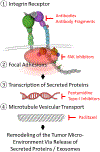The role of integrins in melanoma: a review
- PMID: 32157692
- PMCID: PMC7167356
- DOI: 10.1111/ijd.14850
The role of integrins in melanoma: a review
Abstract
Integrins are the major family of cell adhesion receptors in humans and essential for a wide range of normal physiology, including formation and maintenance of tissue structure integrity, cell migration, proliferation, and differentiation. Integrins also play a prominent role in tumor growth and metastasis. Translational research has tried to define the contribution of integrins to the phenotypic aggressiveness of melanoma because such knowledge is clinically useful. For example, differential expression of integrins in primary cutaneous melanoma can be used to distinguish indolent from aggressive, prometastatic melanoma. Recent studies have shown that gene expression-based testing of patient-derived melanoma tissue is feasible, and molecular tests may fully replace interventional surgical methods such as sentinel lymph node biopsies in the future. Because of their central role in mediating invasion and metastasis, integrins are likely to be useful biomarkers. Integrins are also attractive candidate targets for interventional therapy. This article focuses on the role of integrins in melanoma and highlights recent advances in the field of translational research.
© 2020 the International Society of Dermatology.
Conflict of interest statement
Figures


Similar articles
-
Factors predicting survival in thick melanoma: Do all thick melanomas have the same prognosis?Surgery. 2020 Sep;168(3):518-526. doi: 10.1016/j.surg.2020.04.048. Epub 2020 Jul 12. Surgery. 2020. PMID: 32669204
-
The role of sentinel lymph node biopsy in the management of thin melanoma.Am J Surg. 2005 Aug;190(2):196-9. doi: 10.1016/j.amjsurg.2005.05.011. Am J Surg. 2005. PMID: 16023430 Review.
-
Is sentinel node status predictive of overall survival in patients with melanoma?Nat Clin Pract Oncol. 2005 Oct;2(10):494-5. doi: 10.1038/ncponc0316. Nat Clin Pract Oncol. 2005. PMID: 16205765 No abstract available.
-
Microphthalmia transcription factor in malignant melanoma predicts occult sentinel lymph node metastases and survival.Melanoma Res. 2015 Dec;25(6):496-502. doi: 10.1097/CMR.0000000000000195. Melanoma Res. 2015. PMID: 26317170
-
Sentinel lymph node biopsy in melanoma: controversies and current guidelines.Future Oncol. 2014 Feb;10(3):429-42. doi: 10.2217/fon.13.245. Future Oncol. 2014. PMID: 24559449 Review.
Cited by
-
Gene Expression Patterns of Osteopontin Isoforms and Integrins in Malignant Melanoma.Pathol Oncol Res. 2022 Aug 24;28:1610608. doi: 10.3389/pore.2022.1610608. eCollection 2022. Pathol Oncol Res. 2022. PMID: 36091936 Free PMC article.
-
Advances in Melanoma: From Genetic Insights to Therapeutic Innovations.Biomedicines. 2024 Aug 14;12(8):1851. doi: 10.3390/biomedicines12081851. Biomedicines. 2024. PMID: 39200315 Free PMC article. Review.
-
Correlation Between Endoglin and Malignant Phenotype in Human Melanoma Cells: Analysis of hsa-mir-214 and hsa-mir-370 in Cells and Their Extracellular Vesicles.Adv Exp Med Biol. 2023;1408:253-272. doi: 10.1007/978-3-031-26163-3_14. Adv Exp Med Biol. 2023. PMID: 37093432
-
Irisin and Metastatic Melanoma: Selective Anti-Invasiveness Activity in BRAF Wild-Type Cells.Int J Mol Sci. 2025 Jan 14;26(2):652. doi: 10.3390/ijms26020652. Int J Mol Sci. 2025. PMID: 39859367 Free PMC article.
-
ITGB5 is a prognostic factor in colorectal cancer and promotes cancer progression and metastasis through the Wnt signaling pathway.Sci Rep. 2025 Mar 18;15(1):9225. doi: 10.1038/s41598-025-93081-7. Sci Rep. 2025. PMID: 40097546 Free PMC article.
References
-
- Hynes RO. Integrins: bidirectional, allosteric signaling machines. Cell. 2002;110(6):673–687. - PubMed
-
- Wegener KL, Partridge AW, Han J, et al. Structural basis of integrin activation by talin. Cell. 2007;128(1):171–182. - PubMed
-
- Winograd-Katz SE, Fässler R, Geiger B, Legate KR. The integrin adhesome: from genes and proteins to human disease. Nature Reviews Molecular Cell Biology. 2014;15(4):273–288. - PubMed
-
- Gu Y, Liu Y, Fu L, et al. Tumor-educated B cells selectively promote breast cancer lymph node metastasis by HSPA4-targeting IgG. Nat Med. 2019. - PubMed
Publication types
MeSH terms
Substances
Grants and funding
LinkOut - more resources
Full Text Sources
Medical

